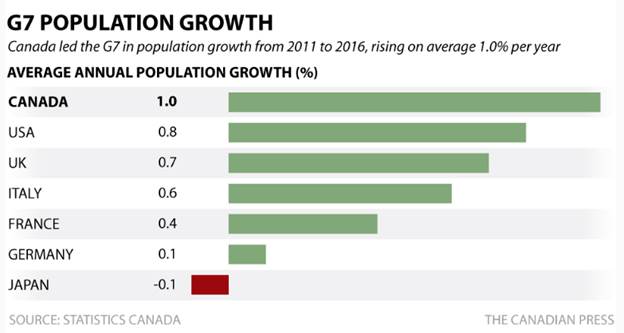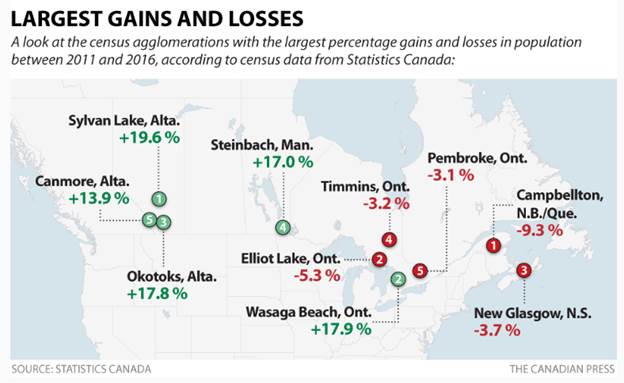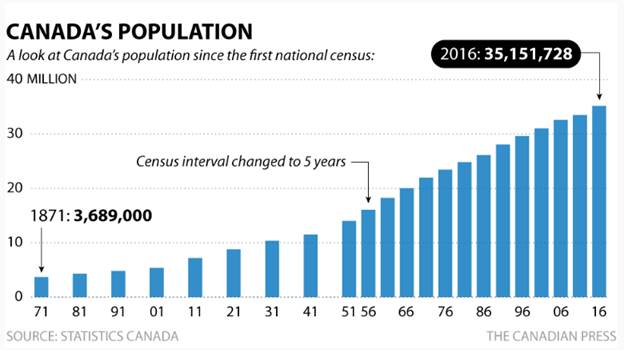
Immigration fuels Canada’s population growth of 1.7 million in five years: latest census
The country’s population reached 35.2 million in 2016, an increase of 1.7 million over 2011, the strongest growth of all the G7 countries.
TheStar.com
Feb. 8, 2017
Bruce Campion-Smith
Immigration, urbanization and a burgeoning west.
That’s the story of the nation, revealed Wednesday as Statistics Canada began its year-long roll-out of data collected in the 2016 census.
Statistics Canada counted 35,151,728 people in its May 2016 census, a 5 per cent increase over the 2011 national count, and 14 million private dwellings, up 5.6 per cent.
Toronto held its title as Canada’s largest city, with 2,731,571 residents, 7.8 per cent of the country’s population. That’s one million more than Montreal, the second-place city, with 1,704,694 residents.
Four cities in the Golden Horseshoe — Toronto, Mississauga, Brampton and Hamilton — ranked among the top 10 largest Canadian cities.
The new numbers reveal that Canada’s population grew by 1.7 million people since the last census in 2011. Immigrants accounted for two-thirds of the increase and the so-called natural increase — the difference between births and deaths — accounted for the rest.
Over the coming years, newcomers to Canada will account for more and more of the country’s population growth due to low fertility and an aging population.
“Deaths will be catching up to the number of births in Canada . . . the large baby boom cohort is moving to older ages where mortality is higher,” said Laurent Martel, director of the demography division at Statistics Canada.
“Fifty years from now, basically all population growth in Canada will be related to another factor which will be immigration. We know already that natural increase will no longer be a key contributor,” he said Wednesday in an interview.
Canada’s population growth slowed in the last five years, compared to the previous census period when the country grew by 5.9 per cent, but still led all G7 nations.

In the census done five years ago, the story was of a nation growing and going west. That’s the story this time around too, with Canada’s surging western provinces all recording above-average increases in population.
Population growth accelerated in both Manitoba, up 5.8 per cent, and Alberta, which led all provinces with an 11.6 per cent increase, despite the oil patch slowdown that has slowed its economy.
Urban areas in the west were also fast-growing with Canada’s fastest growing urban areas were in the west with Calgary leading the way (up 14.6 per cent), followed by Edmonton (13.9 per cent), Saskatoon (12.5 per cent) and Regina (11.8 per cent).
Ontario — Canada’s most populous province with 13.5 million people — grew by 4.6 per cent. It’s the second census in a row that the province’s growth rate has been below the national average.
“Are we seeing a new pattern for Ontario where growth will be slightly lower than the national average? Who knows,” Martel said.
Still, Guelph, Oshawa, Toronto, Barrie, Ottawa and the Kitchener-Waterloo region were among the larger Ontario centres that saw above-average growth.
Immigrant settlement is behind much of the regional differences in population growth.
“We know that the geographic distribution of immigrants has changed slightly over the last few years. More are going towards Saskatchewan and Manitoba and less to Ontario and that explains in large part why the population growth in Ontario has decreased,” he said.
New Brunswick was alone in seeing its population actually drop, falling by 0.5 per cent. The population of Saint John fell by 2.2 per cent, blamed on people moving out of the province.
Indeed, Atlantic Canada’s share of the population has dropped over the years because of lower population growth. In 2016, 6.6 per cent of Canadians lived in the region, compared with 10 per cent in 1966.
Population growth slowed in Ontario and Quebec but the two provinces still accounted for 61.5 per cent of the Canadian population.
Nunavut took top spot as the fastest growing province or territory, seeing its population jump by 12.7 per cent, to 35,944 residents, thanks to the highest fertility level in the country. Women in Nunavut give birth to 2.9 children on average, compared to the national average of 1.6 children.
The census numbers track the changing fortunes of towns and cities across the nation. Warman, Sask. took the prize as the country’s fastest growing town or city with a 55 per cent jump in its population to 11,020. Shelburne, Ont. saw its population jump by 39 per cent.
At the other end of the scale were towns like Bonnyville, Alberta, Flin Flon, Manitoba, and the Ontario communities of Espanola, Kirkland Lake and Elliot Lake, which all lost residents.

Still, the latest census data confirms the continuing urbanization of Canada with 83 per cent of its population now living in cities. And the large urban areas grew by 7.9 per cent, faster than the overall growth in population.
“Canada was a rural country 150 years ago at Confederation. Now, we’re among the countries in the world with the largest proportion of the population living in metropolitan areas,” Martel said.
The census data also shows that population growth was higher in so-called peripheral municipalities (up 6.9 per cent) compared with central municipalities (5.8 per cent). “This is very valuable information for those who are planning public transportation,” Martel said.

Canada had just 3.9 people per square kilometre in 2016, compared with 35.3 people per square kilometre in the United States. But the country’s population is highly concentrated with two out of three people living within 100 kilometres of the U.S. border.
The census is the twice-a-decade snapshot of the nation, providing an in-depth look at the size of the population, its make-up and details of how Canadians live.
Wednesday’s release is the first set of data from the 2016 census. Over the coming months, Statistics Canada will release other information from the census on age and sex of Canada’s population, income, language, immigration and ethocultural diversity, marital status, education and commuting patterns.
Quick facts
- the population count in 2016 was 10 times greater than in 1871, when the first census after Confederation recorded 3.5 million residents in Canada. By 1967, the population had grown to 20 million.
- Canada’s annual population growth rate of 1 per cent between 2011 and 2016 led G7 nations and ranked eighth among the G20 countries.
- there are 5,162 municipalities in Canada. Of these, 24 had a population of at least 200,000 residents.
- close to two in five Canadians live in the 15 largest municipalities.
- with birth rates declining, immigration has fuelled Canada’s population growth since the end of 1990s.
- Quebec’s population surpassed the 8-million mark for the first time in census history. However, the province’s population growth has lagged the national average for the last 40 years and its share of the country’s population has dropped to 23 per cent, from 29 per cent in 1966.
- Vancouver had the highest population density in Canada, with more then 5,400 people per square kilometre. Toronto had 4,334 people per square kilometre.
- Canada’s population grew by 3 per cent a year between 1901 and 1911, the fastest rate in its history.
